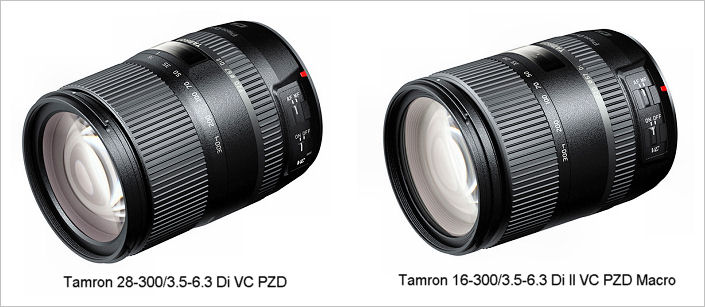

Tamron 28-300/3.5-6.3 Di VC PZD and
Tamron 16-300/3.5-6.3 Di II VC PZD Macro
Tamron has announced the development of two new lenses. They both cover similar focal length ranges, but one has full frame coverage (28-300/3.5-6.3 Di VC PZD) while the other is designed for APS-C sensor cameras (Tamron 16-300/3.5-6.3 Di II VC PZD Macro)

The APS-C lens, the Tamron 16-300/3.5-6.3 Di II VC PZD Macro, has the widest zoom range of any APS-C telephoto zoom (18.8x) and has a field of view equivalent to a 25.6-480mm zoom on a full frame camera (when used on a Canon EOS APS-C DSLR), or when used on a Sony or Nikon DSLR the equivalent field of view is 24-450mm. The "Macro" in the name refers to the close focusing ability, giving a maximum magnification of 0.345 (just over 1/3 life size) at a focus distance of 0.39m (15.3 in). The lens construction features 16 elements in 12 groups. This includes three Molded-Glass Aspherical elements, one Hybrid Aspherical element, two LD (Low Dispersion) elements, one XR (Extra Refractive index) glass element, and one element of UXR (Ultra-Extra Refractive Index) glass, which has greater refractive index than XR.
The Full frame lens, the Tamron 28-300/3.5-6.3 Di VC PZD appears very similar in external design and can be used on both full frame and APS-C sensor DSLRs. When used on a Canon EOS APS-C DSLR the equivalent field of view is 44.8-480mm. Though it doesn't focus quite so close as the 18-300, it still achieves a maximum magnification of 0.286x at a close focus distance of 0.49m (19.3 in). The optical construction of this lens includes four elements of LD (Low Dispersion) glass, three Molded-Glass Aspherical elements, one Hybrid Aspherical element, one XR (Extra Refractive Index) glass element, and one element of UXR (Ultra-Extra Refractive Index) glass, which has greater refractive index than XR.
Both lenses have Tamron's usually excellent VC optical stabilization and both use Tamron's PZD ultrasonic focusing motors for fast and quiet operation. Both lenses take 67mm filters and come with a "petal" style lens hood. Both lenses also feature a moisture proof design and have a 7 blade circular aperture. Note that the Sony mount lens will not be optically stabilized since Sony DSLRs have stabilization via sensor shift in the camera body.
As of now (02/09/14) price and availability have not been announced. For reference the current 28-300 Di lens is selling for around $420 and the current 18-270 Di II lens is selling for around $430, so I'd expect the price on both new lenses to be in the $450 range. Tamron lenses are usually available within a month or two of announcement, so my guess is maybe March/April 2014 - though that's just a guess.
Tamron 16-300/3.5-6.3 Di II VC PZD Macro and 28-300/3.5-6.3 Di VC PZD Specifications
| Model | A010 - 28-300/3.5-6.3 Di VC PZD | B016 - 16-300/3.5-6.3 Di II VC PZD Macro |
|---|---|---|
| Coverage | Full Frame | APS-C |
| Focal Length | 28-300mm | 16-300mm |
| Maximum Aperture | f/3.5-6.3 | f/3.5-6.3 |
| Minimum Aperture | f/22-40 | f/22-40 |
| Angle of View (diagonal) | 75°23’ – 8°15’ (for full-frame format) 52°58’ – 5°20’ (for APS-C format) |
82°12’ - 5°20’ |
| Lens Construction | 19 elements in 15 groups | 16 elements in 12 groups |
| Minimum Focus Distance | 0.49m (19.3 in) | 0.39m (15.3 in) |
| Maximum Magnification | 1:3.5 (at f=300mm: MFD 0.49m) | 1:2.9 (at f=300mm: MFD 0.39m) |
| Filter Size | 67mm | 67mm |
| Maximum Diameter | 74.4mm | 75mm |
| Length | 96mm (3.8 in) | 99.5mm (3.9 in) |
| Weight | 540g (19 oz) | 540g (19 oz) |
| Diaphragm Blades | 7 (circular diaphragm) | 7 (circular diaphragm) |
| Standard Accessories | Flower-shaped lens hood | Flower-shaped lens hood |
| Compatible Mounts | Canon, Nikon, Sony | Canon, Nikon, Sony |
